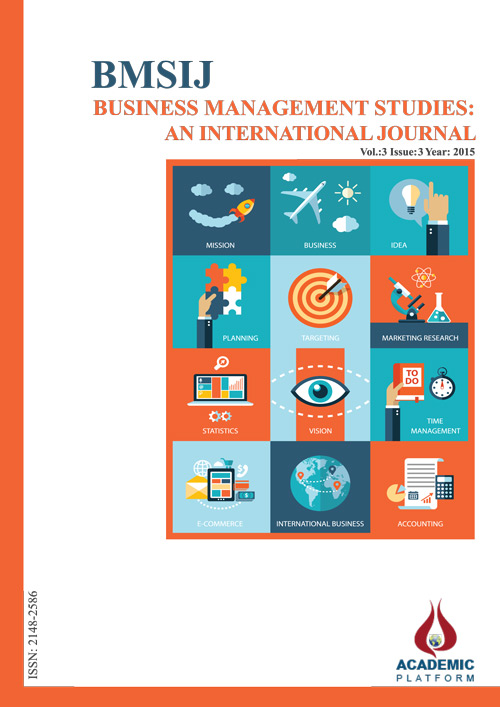KAPSAMLI KÂR ŞİRKETİN GELECEKTEKİ PERFORMANSININ TAHMİN EDİLMESİNDE NET KÂRA GÖRE NE KADAR BAŞARILI? HALKA AÇIK TÜRK ŞİRKETLERİNDEN BULGULAR

Yayınlanmış 2016-01-11
Anahtar Kelimeler
- Uluslararası Finansal Raporlama Standartları,
- Finansal Performans,
- Kapsamlı Kâr
Nasıl Atıf Yapılır
Özet
Firmaların finansal performansı mali tablo kullanıcılarının en çok ilgilendiği konular arasındadır. Muhasebe standardı belirleyici (yapıcı) kuruluşları firmaları net kârdan daha fazla değer ilgililiği olduğu düşünülen kapsamlı kârı raporlamaları konusunda yönlendirmektedir. Bu çalışmanın amacı, kapsamlı kârın ve net kârın firmanın gelecekteki performansının tahmin edilmesindeki yararlılığını değerlendirmektir. Finans sektöründe faaliyet göstermeyen 102 şirketin verilerine dayanan ampirik analizin sonuçlarına göre, kapsamlı kârın raporlanması şirketin gelecekteki performansının tahmin edilmesinde önemli avantajlar sunmaktadır. Ampirik analizin sonuçlarına göre, net kâr gelecekteki faaliyet kârının ve net kârın tahmin edilmesinde kapsamlı kâra göre daha yüksek performans sergilerken, kapsamlı kâr ise gelecekteki varlık kârlılığının ve öz sermaye kârlılığının tahmin edilmesinde net kâra göre daha yüksek performans sergilemektedir.
İndirmeler
Referanslar
- ASB (1992). FRS 3 Reporting Financial Performance, available at: https://frc.org.uk/Our-Work/Codes-Standards/Accounting-and-Reporting-Policy/Standards-in-Issue/FRS-3-Reporting-Financial-Performance.aspx (accessed 15 March 2015).
- Balsari, C. K. and Varan, S. (2014). IFRS implementation and studies in Turkey. Accounting and Management Information Systems, Vol. 13 No.2, pp. 373-399.
- Biddle, G. C. and Choi, J. H. (2006). Is comprehensive income useful?. Journal of Contemporary Accounting and Economics, Vol. 2 No. 1, pp. 1-32.
- Brimble, M. and Hodgson, A. (2005). The value relevance of comprehensive income and components for industrial firms. Working Paper, Griffith University and Amsterdam Business School Universiteit of Amsterdam.
- Cahan, S. F., Courtenay, S. M., Gronnewoller, P. L., and Upton, D. R. (2000). Value relevance of mandated comprehensive income disclosures. Journal of Business Finance and Accounting, Vol. 27 No.9‐10, pp.1233-1265.
- Chambers, D., Linsmeier, T. J., Shakespeare, C., and Sougiannis, T. (2007). An evaluation of SFAS No. 130 comprehensive income disclosures. Review of Accounting Studies, Vol.12 No. 4, pp. 557-593
- Cheng, C. S., Cheung, J. K., and Gopalakrishnan, V. (1993). On the usefulness of operating income, net income and comprehensive income in explaining security returns. Accounting and Business Research, Vol. 23 No. 91, pp. 195-203.
- Cihangir, E. (2006). The value relevance of comprehensive income: An application at Istanbul stock exchange. Unpublished Master Thesis. Dokuz Eylül University. İzmir, Türkiye.
- Choi, J.H., Das, S., and Zang, Y. (2007). Comprehensive income, future earnings and market mispricing. Working Paper, Seoul National University, March 2007.
- Demir, V., Bahadır, O., and Öncel, A.G. (2013). En iyi finansal performans ölçümü nedir? Kapsamlı kar’a karşılık net kar: Türkiye’de elde edilen bulgular. İktisat İşletme ve Finans, 28(323), 73-96.
- Dhaliwal, D., Subramanyam, K. R., and Trezevant, R. (1999). Is comprehensive income superior to net income as a measure of firm performance?. Journal of Accounting and Economics, Vol. 26 No. 1, pp. 43-67.
- Epstein, B.J. and Jermakowicz, E.K. (2008). Wiley IFRS 2008: Interpretation and Application of International Accounting and Financial Reporting Standards, 5th ed. John Wiley and Sons, New Jersey, NJ.
- Financial Accounting Standards Board (1997). Statement of Financial Accounting Standard No. 130: Reporting Comprehensive Income.
- Grüber, S. (2014). Intangible Values in Financial Accounting and Reporting: An Analysis from the Perspective of Financial Analysts, Springer.
- Hirst, D.E. and Hopkins, P.E. (1998). Comprehensive income disclosures and analysts' valuation judgments, available at SSRN: http://ssrn.com/abstract=63588 or http://dx.doi.org/10.2139/ssrn.63588 (accessed 18 March 2015).
- Hunton, J. E., Libby, R., and Mazza, C. L. (2006). Financial reporting transparency and earnings management. The Accounting Review, Vol. 81 No. 1, pp. 135-157.
- International Accounting Standards Board (2007). IAS 1 Presentation of Financial Statements.
- Kanagaretnam, K., Mathieu, R., and Shehata, M. (2009). Usefulness of comprehensive income reporting in Canada. Journal of Accounting and Public Policy, Vol. 28 No. 4, pp. 349-365.
- Keating, M. (1999). An analysis of the value of reporting comprehensive income. Journal of Accounting Education, Vol. 17 No. 2, pp. 333-339.
- Kieso, D. S., Weygandt, J. J., and Warfield, T. D. (2011). Intermediate Accounting IFRS Edition. John Wiley and Sons, New Jersey, NJ.
- Köse, Y., and Gürkan, S. (2014). Diğer kapsamlı gelir ile işletmenin piyasa değeri arasındaki ilişki: Borsa İstanbul’da işlem gören şirketlerde bir araştırma. World of Accounting Science, 16(1).
- Maines, L. A. and McDaniel, L. S. (2000). Effects of comprehensive-income characteristics on nonprofessional investors' judgments: The role of financial-statement presentation format. The Accounting Review, Vol. 75 No. 2, pp. 179-207.
- McCoy, T. L., Thompson, J. H., and Hoskins, M. A. (2009). Early evidence of the volatility of comprehensive income and its components. Academy of Accounting and Financial Studies Journal, Vol. 13 No. Summer, pp. 83-92.
- Membership of IASB and FASB International Working Group on Performance Reporting Announced, 2004a.
- Pronobis, P. and Zülch, H. (2011). The predictive power of comprehensive income and its individual components under IFRS. Problems and Perspectives in Management, Vol. 9 No. 4, pp.72-88.
- Schroeder, R. G., Clark, M., and Cathey, J. (2001). Financial Accounting Theory and Analysis. 7th ed. John Wiley and Sons, New York, NY.
- Skinner, D. J. (1999). How well does net income measure firm performance? A discussion of two studies. Journal of Accounting and Economics, Vol. 26 No. 1, pp. 105-111.
- Yen, A. C., Hirst, D. E., and Hopkins, P. E. (2007). A content analysis of the comprehensive income exposure draft comment letters. Research in Accounting Regulation, Vol. 19 pp. 53-79.

